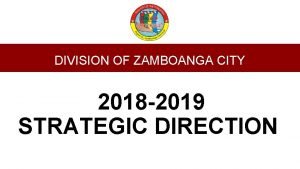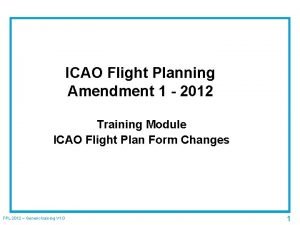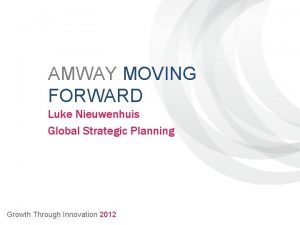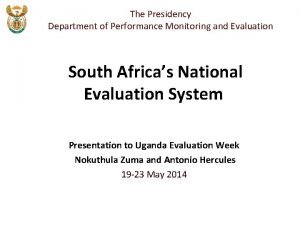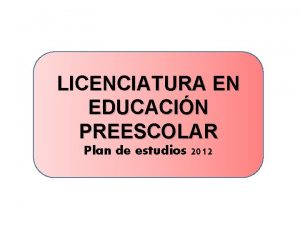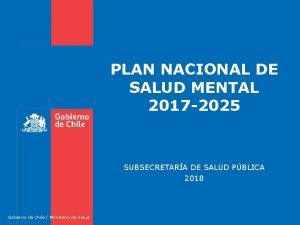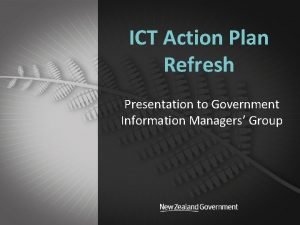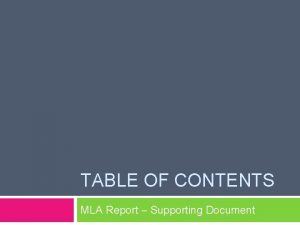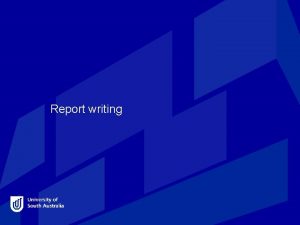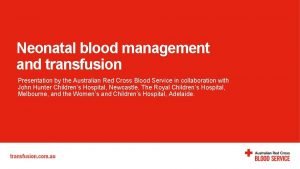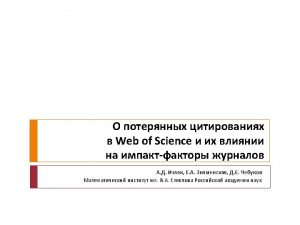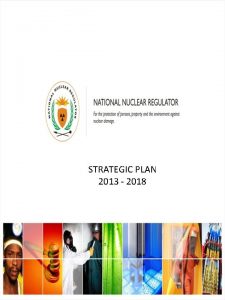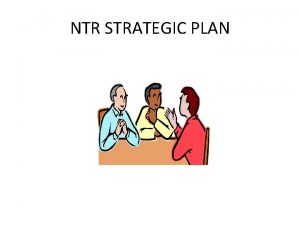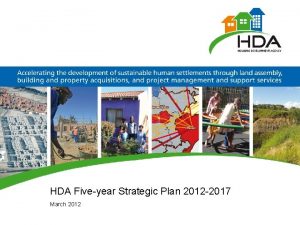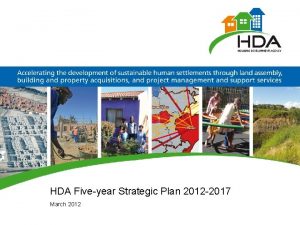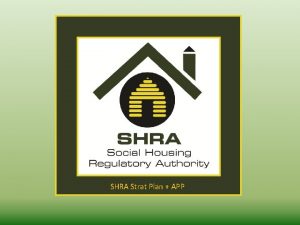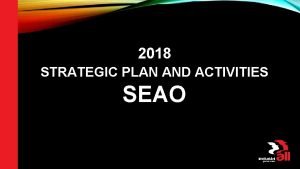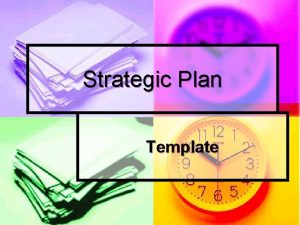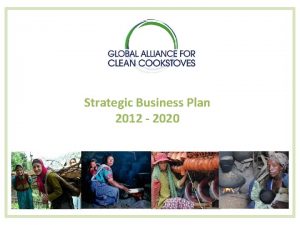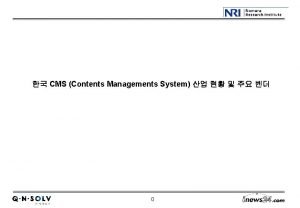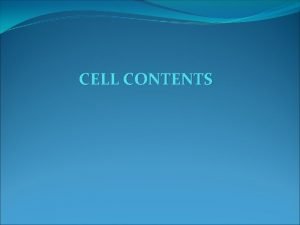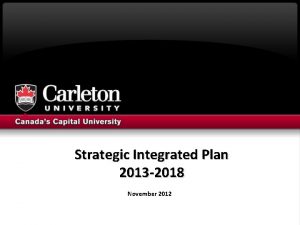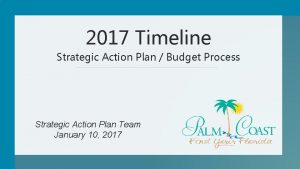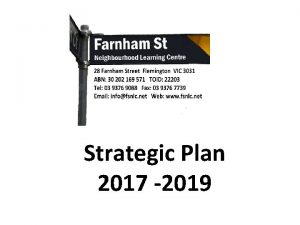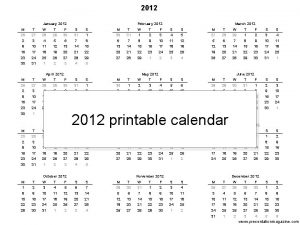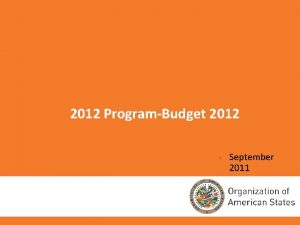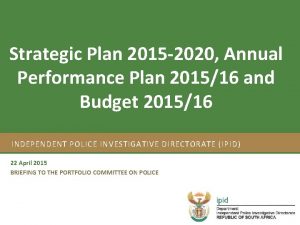STRATEGIC PLAN 2012 2017 CONTENTS 1 STRATEGIC PLAN

































- Slides: 33

STRATEGIC PLAN 2012 - 2017

CONTENTS 1. STRATEGIC PLAN 1 -18 2. ANNUAL PLAN 19 -28

Part A: STRATEGIC OVERVIEW VALUES Value Description Professionalism We hold ourselves accountable to the highest standards of professionalism in everything we do Integrity We demonstrate integrity and ethical conduct in all we do Excellence We strive for excellence in all we do Valuing People We demonstrate that we value our people in all we do Team Work We demonstrate a team working approach across the NNR Openness and transparency We demonstrate openness and transparency in our interactions with all stakeholders MISSION STATEMENT To provide and maintain an effective and efficient national regulatory framework for the protection of persons, property and the environment against nuclear damage VISION To be an independent world class regulatory authority on nuclear safety NNR Corporate Score Card 2011 - 17 3

NNR STRATEGIC OUTCOME ORIENTED GOALS 1. Effective Regulatory oversight and framework to assure Nuclear Safety and Security 2. Strengthen stakeholder relations and enhance corporate image 3. Create a high performance culture 4. Ensure financial viability and sustainability of the organisation 5. Develop and maintain sound organizational infrastructure 6. Enhance good governance 7. Ensure effective Human Capital Management

NNR Strategy Map: Strategic Goals and Objectives Customer & Stakeholder Perspective Effective Regulatory To assure that framework to assure To process holders have an applications for effective Nuclear Safety and nuclear emergency Security authorisations in a preparedness plan To establish an timely and accurate independent manner. To benchmark and verification update safety standards capability for the and regulatory practices NNR To assure in line with national & holder’s international norms and compliance with requirements. regulatory To assure effective requirements To undertake implementation of regulatory research nuclear security that ensures that the measures by holders. regulatory regime is strengthened Finance Perspective To ensure that the NNR continues to remain a financially viable entity Internal Processes perspective To develop and maintain independent and effective governance structures To ensure compliance with applicable legislation and policy framework Good Governance To improve and maintain an effective system of internal controls and risk management Learning & Growth Perspective Strengthen NNR ability to undertake independent verification of holder submissions inspections, audits, investigations and taking of enforcement action for identified non-compliances Financial Viability and Sustainability of the Organisation To establish and maintain a high performance culture through defining, developing and implementing quality management programs and standards To be the employer of choice To ensure that the NNR is positioned to respond to initiatives relating to nuclear expansion Stakeholder relations and enhance the corporate image of the NNR To improve NNR quality of work and effectiveness through compliance with national and international obligations as prescribed by the NNR Act To strengthen stakeholder relations and improve public perceptions of the NNR To ensure prudent financial management in the NNR High Performance Culture Sound Organisational Infrastructure Develop and maintain sound organisational infrastructure Effective Human Capital Management *The Strategy map shows the interconnectedness between the perspectives To have satisfied and productive employees 5

PROGRAM PURPOSE Program Standards Authorisations Assessments (SARA) Purpose & Reviews The Standards, Authorisations Reviews and Assessments (SARA) division provides strategic leadership and management in the following areas; Authorisations of Nuclear Vessel Licences(NVL), Nuclear Installations(NIL), Certificate of Registrations (COR) and Certificates of Exemption (COE). The program produces standards related to the core themes such as risk analysis, structural analysis, nuclear engineering and structural engineering. The reviews and assessments are conducted with regard to design safety, radiation protection, environmental and operational safety. Managing of special projects such as the Fukushima project, Radiation Protection and Nuclear New Build. Research and development is conducted on emerging issues regarding radiation protection

PROGRAM PURPOSE Program Purpose Compliance Assurance and Enforcement (CAE) Division The Compliance Assurance and Enforcement (CAE) division provides strategic leadership and management of the compliance and enforcement activities, processes and programmes for all the regulated nuclear technologies and licence holders. The CAE division ensures the establishment of effective and efficient delivery systems related to the compliance assurance and enforcement activities in nuclear safety and security. This includes conducting compliance assurance inspections, audits, investigations, surveillances, environmental monitoring and sampling

PROGRAM PURPOSE Program Purpose Communication & Stakeholder Relations This programme provides strategic leadership for purposes of ensuring coherent coordination, consistency, quality, impact and responsiveness of NNRs communications and stakeholder engagements. It also assists to strengthen the system of NNR’s communications and face-to-face engagements through sound stakeholder relations. This programme is also responsible for ensuring that the public is accurately informed about matters relating to nuclear safety and the roles and responsibilities of the NNR.

PROGRAM PURPOSE Program Purpose Corporate Support Services This programme provides strategic leadership and direction in the areas of Human Capital Management, Facilities Management, ICT and Occupational Health and Safety. The primary focus of the programme is in ensuring efficient processes and resources in support of the organization’s strategic objectives.

PROGRAM PURPOSE Program Purpose Financial Management & Administration This programme provides strategic financial leadership for the purposes of managing and directing the Finances of the NNR. The management includes financial planning, financial reporting, safeguarding of assets, enforcing adherence to applicable legislations, effective supply chain processes and efficient usage of public funds. The program also coversight role in implementing financial systems that support robust systems of internal control

PROGRAM PURPOSE Program Purpose Governance: Internal Audit Internal audit provides assurance to the NNR’s stakeholders, that the organisation operates in a responsible manner by performing the following functions, amongst others: • Evaluating the organisation’s governance processes including ethics, especially the ‘tone at the top’; • Performing an objective assessment of the effectiveness of risk management (outsourced) and the internal control framework; • Systematically analysing and evaluating business processes and associated controls; and • Providing a source of information, as appropriate, regarding instances of fraud, corruption, unethical behaviour and irregularities. Internal Audit reports functionally to the Audit and Risk Management Committee (ARMCOM) and Administratively to the CEO.

PROGRAM PURPOSE Program Purpose Risk Management Risk management is a systematic and formalised process instituted by the organisation to identify, assess, manage and monitor risks. While Enterprise-wide Risk Management is the application of risk management throughout the institution rather than only in selected business areas or disciplines. The Internal Audit and Risk department assists management by co-ordinating and facilitating the risk management activities within the NNR.

PROGRAM PURPOSE Program Purpose Company Secretariat This programme provides strategic leadership for purposes of ensuring the effective and efficient functioning of the Board and its Committees. This is done through providing the Board with quality, consistent and responsive administrative and logistical support. It also assists the Board and Board members to discharge their role and responsibilities. The programme is also mandated to ensure that it is the source to provide guidance on good corporate governance principles and practices for the Board and the organisation as a whole. This is done through, inter alia, that NNR’s Board Compliance Index and other measures.

PROGRAM PURPOSE Program Strategy Management Performance Purpose Organisational The purpose of this function is to ensure strategy formulation, development and execution, this includes performance monitoring. The function ensures the realisation of the organisation’s mandate in line with the NNR Act, and utilizing a Strategic Plan that is aligned to National Planning Framework and Priorities. The function also monitors and evaluates organizational performance, providing performance enhancing solutions that will aid in the attainment of performance targets.

RESOURCE CONSIDERATIONS

STRATEGY RISK MANAGEMENT At the time of developing the strategic plan, the NNR had identified the following as key corporate risks, which are being addressed. These are; 1. Financial Viability and Sustainability – The NNR faces a risk of insufficient funding. This is caused by amongst others, the diminishing state allocation coupled with delays in the approval and gazetting of authorisation fees; difficulties in economic conditions and non-payment of authorisation fees by some authorisation holders. The current financial model does not adequately address to the full extent the activities of the NNR. – To address these challenges, the NNR will strive to maintain adequate funding and is therefore in a process of reviewing its funding model with a view to ensuring sustainability. 2. Effective Regulatory Oversight to Assure Nuclear Safety – The NNR is currently developing a comprehensive regulatory framework while reviewing the capacity requirements in line with the strategy and structure. The resulting resource requirements will be submitted to DOE and National Treasury.

STRATEGY RISK MANAGEMENT 3. Strengthening of Stakeholder Relations and Enhance the Corporate Image of the NNR – To address the risks, the NNR has developed and is implementing a comprehensive Communication Strategy 4. Development and Maintenance of Sound Organisational Infrastructure – ICT governance structures and policies are developed and implemented to address a number of previously identified risks. Some of the strategies implemented include: – The development of a three-year ICT strategy – The ICT infrastructure Turnkey project was implemented. The purpose of the project was to refresh the ICT infrastructure of the NNR. The project included upgrading the servers, communication and telephonic infrastructure of the organisation. Phase II of the project included skills transfer and the training of ICT staff on the new technologies which is on going

STRATEGY RISK MANAGEMENT 5. Effective Human Capital – – Scarce nuclear skills and related capacity constraints in the sector and particularly to the NNR. The risk of maintaining an effective human capital has been addressed through the development and implementation of a succession plan and knowledge management strategies

ANNUAL PERFORMANCE PLAN

Goal 1: Effective Regulatory framework to assure Nuclear Safety and Security Goal 2: Strengthen stakeholder relations and enhance the corporate image of the NNR Customer & Stakeholders Summary of Measures & KPIs Objective Measure KPI What does it measure? Targets To process applications for nuclear authorisations in a timely and accurate manner. CM 1 a: Quality of Authorisations Issued CM 1 a: % Licenses issued in accordance with set standards and requirements Quality 100% authorisations issued in accordance with standards and regulations CM 1 b: Level of responsiveness on various authorisations CM 1 b: Number of days (Turn around time (TAT) Responsive ness Co. R: 90 days; COE: 180 days; NVL: 180 days; <20% deviation on plan CM 2 a: Quality compliance assurance activities conducted CM 2 a: The quantity of activities conducted in the three broad categories of NORM, NTWP & KNPS Volume of work 341 (KP 51; NTWP : 76; NORM: 214) CM 2 b: Effectivene ss of enforcement actions taken CM 2 b: Zero/No repeat offences within 12 months of issuance of directive Effectivene ss & Impact 0 CM 2 c: Level of compliance CM 2 c: Improvement in compliance index to increase at the rate of 5% progressively Effectivene ss & Impact 5% increase from previous level To assure holder’s compliance with regulatory requirements

Goal 1: Effective Regulatory framework to assure Nuclear Safety and Security Goal 2: Strengthen stakeholder relations and enhance the corporate image of the NNR Customer & Stakeholders Summary of Measures & KPIs Objective Measure KPI What does it measure? Targets (2012/13) To assure that holders have an effective emergency preparedness plan CM 3: Percentage of corrective actions undertaken and validated CM 3: Extent to which holders have addressed issues raised by the NNR as per agreed schedule Effectivene ss 100% corrective action per agreed schedule addressing recommendatio ns in the NNR final report To provide assurance of safety performance of holders through inspections, audits, investigation and taking of enforcement action for identified non-compliance CM 4: Harmonised compliance assurance and enforcement program Output 100% development of program by Q 4 (11/12) To benchmark and update safety standards and regulatory practices CM 5: Percentage completion of the NNR specific SAT program of action 60% implementation of program by Q 4 2012/13 CM 5: % implementation of the program of action Quality & Output 42% of the implementation plan to be completed by

Goal 1: Effective Regulatory framework to assure Nuclear Safety and Security Goal 2: Strengthen stakeholder relations and enhance the corporate image of the NNR Customer & Stakeholders Summary of Measures & KPIs Objective Measure KPI What does it measure? Targets (2012/13) To assure effective implementation of nuclear security measures by holders. CM 6: Implementatio n of the nuclear security strategy CM 6: % implementation of the strategy over stipulated period of time Output 40% implementation of strategy by Q 4. of 2011/12. 55% implementation of Strategy in 2012/13. To establish an independent verification capability for the NNR CM 7: Implementatio n of the key project milestones (for the establishment of independent analytical capability) CM 7: % completion of action plan Output 25% of the action plan (i. e. commencement with refurbishment of laboratories. CM 8: Research plan of action; Relevant studies covering emerging areas for safety regulation CM 8: Number of approved Position Papers and Procedures To undertake regulatory research that ensures that the regulatory regime is strengthened 40%implementation in 2012/13. Output Recommendations from Position papers on: Environment; Radon Dwellings; Depleted Uranium; Procedures for Radiological verification system and radiological site characterisation 22 framework

Goal 1: Effective Regulatory framework to assure Nuclear Safety and Security Goal 2: Strengthen stakeholder relations and enhance the corporate image of the NNR Customer & Stakeholders Summary of Measures & KPIs Objective Measure KPI What does it measure? Targets (2012/13) To ensure that the NNR is positioned to respond to initiatives relating to nuclear expansion CM 9: Plan of action covering pre-licensing issues related to nuclear expansion CM 9: Approved Position Papers in relation to nuclear expansions Output Recommendations from Position Paper (PP) on Manufacturing; Types of Nuclear Authorisations ; Workshop Draft PP with Eskom. All by Q 4 2011. To strengthen stakeholder relations and improve public perceptions of the NNR CM 10: Stakeholde r perception index CM 10: (%) Level of improvement in stakeholder, (including public)perceptions of NNR Impact & perception 60% level of Stakeholder positive perceptions of NNR To improve NNR quality of work and effectiveness through compliance with national and international obligations as prescribed by the CM 11: New/needful and necessary improvement made to the NNR due to participation in CM 11: Number of implemented improvements Quality & best practice learning At least 1 improvement a year 23

Goal 4: Ensure Financial Viability and Sustainability of the Organisation Financial Summary of Measures & KPIs Objective Measure KPI What does it measure? Targets (2012/13) To ensure that the NNR continues to remain a financially viable entity i. e. Adequate revenue to meet NNR strategic objectives FM 1 : Level funding/ cost strategic program FM 1: Ratio Adequacy of funding 1: 1 To ensure prudent financial management in the NNR i. e. Ensure that Strategic objectives are executed in accordance with allocated funds FM 2: Variation from budget FM 2: % budget variation (either positive or negative) Efficient use of funds <5% i. e. less than 5% variation from budget

Goal 3: Create a High Performance Culture Goal 5: Develop and Maintain Sound Organisational Infrastructure Goal 6: Enhance Good Governance Internal Processes Summary of Measures & KPIs Objective Measure KPI What does it measure? Targets(2012/13) To improve and maintain an effective system of internal controls PM 1: Unqualifi ed audit (external) Rating (Qualified unqualified) Quality Unqualified Audit Report; To improve and maintain an effective system of internal controls and risk management PM 2: Risk maturity level Rating / level Quality Measure Level 3 maturity To develop and maintain independent and effectivegovernance structures PM 3: Level of Effectiveness of the NNR Board PM 3: % performance of the Board Effectiveness Measure Annual Target: 80% level of Board Effectiveness Develop and maintain sound organisational infrastructure PM 4: Infrastruc ture down time (TAT) PM 4: Length of time it takes to restore systems when there had been a breakdown / blackout/ shutdown i. e. Number of days Efficiency & Effectiveness Measure 2 days down time (from the time of the system breakdown to the time they have been restored) / risk

Goal 3: Create a High Performance Culture Goal 5: Develop and Maintain Sound Organisational Infrastructure Goal 6: Enhance Good Governance Internal Processes Summary of Measures & KPIs Objective Measure KPI What does it measure ? Targets(2012/ 13) To establish and maintain a high performance culture through defining, developing and implementing quality management programs and standards PM 5 a: Organisa tional Excellence Rating PM 5 a: Rating in points and % Based on the Business Excellence Quality Model Quality 600 excellence points. (score for criterion part x factor = excellence level) PM 5 b: Level of Organisational performance PM 5 b: % performance of the NNR Annual Plan implementation Effective ness 80% (4) To ensure compliance with applicable legislation and policy framework PM 6: Legislativ e compliance index % Level of compliance with legislative requirements Quality 80% level of legislative compliance

Goal 7: Ensure Effective Human Capital Management Learning & Growth Summary of Measures & KPIs Objective Measure KPI What does it measure? Targets(2012/13 ) To have satisfied and productive employees LM 1: Employe e satisfaction level LM 1: % of satisfaction employee Effectivene ss Perception measure 70% Employee satisfaction level To be the employer of choice LM 2: Average staff performance level LM 2: % Average employee performance level Output and effectivene ss measure 80% (4) Average employee performance level

Key Projects in 2013 • Steam Generator Replacement (SGR) project for the Koeberg Plant. • Review and assess the authorisation applications and associated Safety cases i. e. the Dedicated Isotope Production Reactor (DIPR) project). • Development of a viable funding model. • Disaster recovery program (back up facility available to ensure no loss of data due to theft or destruction of computer equipment). • New Build (early engagement).

NNR 2012/13 Budget as submitted ORIGINAL SUBMISSION National Nuclear Regulator: Financial information Statement of financial performance R thousand Revenue Tax revenue Non-tax revenue Sale of goods and services other than capital assets of which: Admin fees Sales by market establishments Other sales Other non-tax revenue Transfers received Total revenue Expenses Current expense Compensation of employees Goods and services Depreciation Interest, dividends and rent on land Transfers and subsidies Total expenses Surplus / (Deficit) Acquisition of assets Revised Audited outcome 2008/09 2009/10 2010/11 estimate 2011/12 Medium-term estimate 2012/13 2013/14 2014/15 – 74 268 65 471 – 90 333 84 882 – 94 649 89 856 – 84 581 82 081 – 106 044 102 115 – 122 149 120 361 – 132 746 132 196 64 513 958 – 8 797 20 333 94 601 84 127 755 – 5 451 23 793 114 126 89 505 351 – 4 793 19 954 114 603 79 726 2 355 – 2 500 35 430 120 011 102 115 – – 3 929 43 260 149 304 120 361 – – 1 788 34 452 156 601 132 196 – – 550 36 558 169 303 94 195 58 241 33 898 1 782 274 – 94 195 406 2 280 104 625 74 751 27 937 1 820 117 – 104 625 9 501 1 910 112 266 74 083 35 209 2 678 296 – 112 266 2 337 21 224 121 109 85 042 31 830 4 216 21 – 121 109 (1 098) 11 810 149 304 105 654 38 455 5 183 12 – 149 304 – 12 135 156 601 169 304 111 982 122 200 39 283 41 627 5 323 5 463 13 13 – – 156 601 169 304 – 2 857

NNR 2012/13 Budget as approved

Budget Variances Major Variances There are two categories that have contributed to a bigger than expected variance. The categories are Compensation of Employees and Goods and Services. Compensation of Employees Additional Staff and new positions Additional staff is necessitated by the two critical projects that the NNR has to embark upon. The Steam Generator Replacement for Koeberg and the New Nuclear Build. The number of resources (additional staff) required is ten resources at an average of R 700 000 per annum. The remaining R 2 million relates to the new positions for the laboratory resources. The NNR is in the process of establishing its own laboratory. The number of resources needed is four (4). The remaining outer years were treated on the same basis of the 6% cost of living adjustment and the average 3. 5% incentive bonus. Goods and services: These are expenses that directly relate to the costing of the strategic objectives to enable the NNR to perform its regulatory mandate. It is inclusive of our fixed costs, consulting fees and administration costs.

Budget Variances Major Variances The implications if the figures in Original Submission are not granted: 1. The organization will move into a deficit as reflected on the Adjusted Budget Table 2. The organization will not fulfill its mandate since the costs to achieve the strategic objectives will be reduced. Amongst others the number of inspection to be performed will be severely impacted. In order to breakeven or to fund the deficit the organization may require to make one or a combination of the following : 1. Increase authorization fees 2. Reduce goods and services 3. Reduce compensation of employees The options in point three above are not desirable as the organization will fail to fulfill its obligations.

Thank You
 Deped strategic directions 2017-2022
Deped strategic directions 2017-2022 Marketing plan
Marketing plan Aircraft equipment codes
Aircraft equipment codes Amway renewal 2014
Amway renewal 2014 Green plan 2012
Green plan 2012 Plan de estudios 2012 licenciatura en educación preescolar
Plan de estudios 2012 licenciatura en educación preescolar Plan nacional de salud mental 2017 a 2025
Plan nacional de salud mental 2017 a 2025 Salon marketing plan 2017
Salon marketing plan 2017 Ict strategy and action plan
Ict strategy and action plan Strategic fit vs strategic intent
Strategic fit vs strategic intent Strategic complements example
Strategic complements example Industrial organization model of above average returns
Industrial organization model of above average returns Cultural aspects of strategy choice
Cultural aspects of strategy choice Sample introduction for portfolio for english
Sample introduction for portfolio for english Deep perineal pouch contents
Deep perineal pouch contents Fresh frozen plasma contents
Fresh frozen plasma contents Febrile non hemolytic transfusion reaction
Febrile non hemolytic transfusion reaction Mediastnum
Mediastnum Subsartorial canal
Subsartorial canal Posterior mediastinum contents
Posterior mediastinum contents The immortal life of henrietta lacks table of contents
The immortal life of henrietta lacks table of contents Medial lemniscus
Medial lemniscus Teres major origin and insertion
Teres major origin and insertion Golden lampstand tabernacle
Golden lampstand tabernacle Comic book table
Comic book table Hepatorenal recess
Hepatorenal recess Mla table of contents
Mla table of contents Stylistic synonyms lexicology
Stylistic synonyms lexicology School magazine cover page
School magazine cover page Continuous variable example
Continuous variable example Appendices in report
Appendices in report Fresh frozen plasma vs platelets
Fresh frozen plasma vs platelets Contents of the middle mediastinum
Contents of the middle mediastinum Posterior mediastinum
Posterior mediastinum
